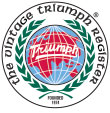The Triumph TR6 Engine Guidelines
by Mark Bradakis.
September 1989
Squeezing a few more horsepower out of the TR6 engine is a perennial question among TR6 owners, particularly when considering the rebuild of a tired engine. This page is intended to provide some information, to help guide you in deciding what, if any, engine modifications make the most sense for your driving style and your TR6.
For those of you who do not read rec.autos.tech, I am in the process of telling everything I know about Triumphs. Here’s the first article.
This is the first in a series (2 or 3 more?) of articles on some basic stuff one can do to get more grunt out of a Triumph straight 6 engine. Hopefully I will remember to use “Triumph” in the keywords so those of you who give neither diddly nor squat about such drivel can kill the probably much too lengthy notes. Those of you who ARE interested would do well to have the following on hand before planning any serious work:
- Bentley service manual for appropriate model
- Competition Preparation Handbook, again as appropriate. Somewhat out of date but always popular. Still full of good advice and details of some stuff.
- Catalogs, from places like The Roadster Factory, Moss, Victoria British. These cover general type parts and supplies for the various models. If in need of addresses, I have them available.
- Specialty catalogs: British Frame and Engine 4831 Ryland Avenue Temple City, CA 91780
Owner Ken Gallanders drag races a TR3 from what I hear. He carries mostly TR3-4 oriented stuff, some six cylinder items. He is one USA source of parts from
Racestorations
Sanders Road
Gainsborough, Lincs. DN21 1Rz
England
Probably the best TR oriented performance catalog is the one from
Triumph Tune
22-28 Manor Road
Richmond, Surrey
England TW9 1YB
- If racing, pertinant rules for sanctioning body and class.
- One more item I was going to mention, but I seem to have misplaced the address. Some fellow recently had an advert in the back of “The English Channel”, the newsletter of the Vintage Triumph Register. He was selling a booklet on TR6 performance, giving a listing of parts, Weber carb settings and so forth, similar to what I plan on dosing out here. He was charging $15, my stuff is free. If that bothers your conscience, donate some bucks to the alternative radio station closest to you, and we’ll call it even. Soliciting funds for the Fat Chance Tool Procurement Fund over the net would probably get me killed. Anyway, I will probably get the booklet myself, just to see what he says. I will post the address in a later note.
Basic info about the Triumph six cylinder engine
The Triumph 6 is a cast iron block, cast iron head pushrod engine of 2 or 2.5 liter displacement. The 2 liter (1998cc) engine was found in the GT6, as well as the Triumph 2000 sedan. An earlier version of 1600 cc or so was fitted to the Vitesse, I believe. This 2 liter 6 has a bore of 2.94 inches and a stroke of 2.992 inches. Basically square. The 2.5 liter engine, actually 2498cc, uses the same bore but increases the stroke three quarters of inch to 3.74 inches. The early TR-250 and TR5 cars even used the same block as the GT6, but later the larger displacement cars got a slightly different block with a bit more clearence at the bottom for the crank throws.
The early GT6 Mark I engine (66-68) had a head with pushrod guides being pressed in tubes, while later cars of both displacements used the same head casting with integral guides. In the long stroke motor the head was used as cast, but the 2 liter got it trimmed down to maintain good compression. [Actually some early cars had different port spacing than later cars.] This will be covered in more detail in the section on heads and intake systems.
Rather than write a lot of confusing numbers, here’s a chart in which all the confusing numbers are well organized. I will use the US of A market and model designations and specs unless noted.
GT6 Mk. I GT6+ GT6 Mk. III TR250 TR6a TR6b Years 66-68 69-70 71-73 68 69-73 74-76 disp. 1998 1998 1998 2498 2498 2498 stroke 2.992 2.992 2.992 3.74 3.74 3.74 CR 8.5:1 9.25:1 9.25:1 8.5:1 8.5:1 7.75:1 bhp 95@5000 95@4700 95@4700 111@4500 104@4500 101@4900 torque 117@3000 117@3400 117@3400 152@3000 142@3000 128@3000
There is some discrepency as to when the low-compression TR6 came about, and what the actual power output is for that motor. Maybe I should have thrown in the specs for 9.5:1 injected TR6 just for fun. Anyway, later cars (75-76?) had 106 bhp but same torque and compression. Look at page 43 of the Bentleys for some further info about which year did what. 72 and 73 TR6s were actually different enough to warrant their own column above, but the chart is wide enough as is. Also, the GT6 Mk. III was manufactured up until december of 73, so you may actually come across a car labeled as a ’74 model year car.
The remainder of the articles will consist of discussions on the various head configurations, intake and exhaust systems, camshaft specs and tuning considerations. I probably won’t belabor you just yet with any chassis preparation stuff.
So given that basic info, send away for some catalogs and think about what sort of performance and usage you REALLY want out of the car. Feel free to email or post any specific questions, comments or complaints. The chances of me being always right are pretty slim, as you might surmise. I never worked for Triumph, I don’t have Kas Kastner’s autograph and I only talked to Mike Cook once years ago about Rotoflex couplings for the GT6.
Mark Bradakis mjb@triumph.cs.utah.edu
